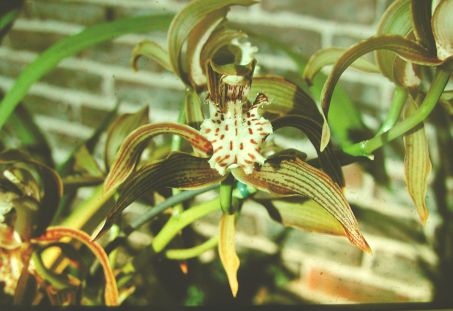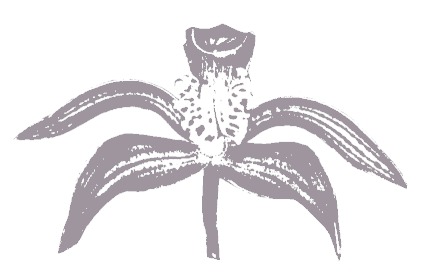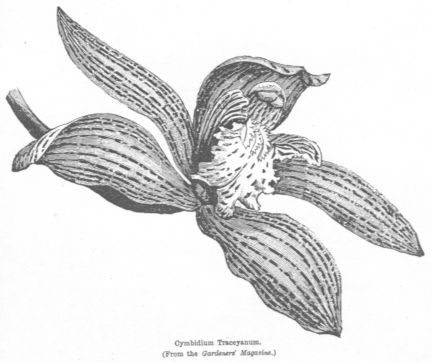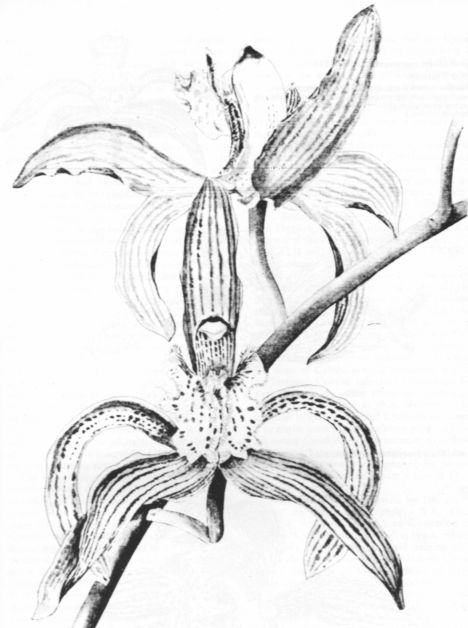
Cymbidium tracyanum 'McNeil' flowered by the author, June 1982.
Photograph by Brian Till
This article was published in the South African Orchid Journal, 14(2): 32-36, June 1983.
An article written by Andy Easton on this species, appearing in the September 1980 American Orchid Society Bulletin, stimulated my interest, and I decided to add Cymbidium tracyanum to my 'much-desired list'. Consequently, when in July 1981 some unpotted divisions of a plant thought to be Cymbidium tracyanum, and given the varietal name 'McNeil', appeared on the Transvaal Orchid Society plant sales bench, I purchased one. It grew well, and in mid-May 1982, a spike of ten flowers opened. To determine whether in fact this really was Cymbidium tracyanum, I consulted all the references I could find, particularly those including illustrations and descriptions. I concluded that my plant compared favourably with all published pictures of Cymbidium tracyanum, most closely resembling the FCC/RHS clone, illustrated in Andy Easton's article. It is, however, not identical with this clone.

During the course of my research, I discovered a number of factual
discrepancies and other peculiarities associated with this Cymbidium, and
further reference work was done to try to sort out these problems. Some have
been sorted out, but at the same time new questions have arisen.
The first discrepancy investigated involved the spelling of the species
epithet. Some authors used traceyanum, ascribing the first blooming to a Mr. A.H. Tracey, others used tracyanum, first flowered by Mr. H.A. Tracy. Obviously only one was correct. Going back
to the original description of the species in the Gardeners' Chronicle, n.s.,
v. 8, p. 718-9, of December 20, 1890, we find the plant referred to as Cymbidium tracyanum and the original owner called Mr. H.A. Tracy. The A.H. Tracey problem appears
to have arisen in Williams' Orchid Grower's Manual, 7th Edition (1891), and was then further copied by Veitch in his Manual of Orchidaceous Plants (1893). These two publications were regarded as orchid growers' 'Bibles' in
their day, and were much copied in later works, leading to a proliferation of
the error. The correctness of the spelling 'tracyanum' is corroborated in Tracy's obituary, published in the Gardeners' Chronicle
27th August 1910, (n.s., v. 48, p. 169), which contains interesting material on
Henry Amos Tracy himself.
He was the proprietor of the Orchid and Bulb Nursery, Amyand Park Road,
Twickenham, which at the time of his death on 10th August 1910, at the age of
60 years, had been established some 25 years. He was a member of the Royal
Horticultural Society Orchid Committee, and despite ill-health in the last
three years of his life, had attended meetings fairly regularly. From long
descriptions of his illness, it appears that he died as a result of a stroke.
There are three significant facts about Tracy. Firstly, he imported orchids and
other plants, and sold them at prices which could be afforded by 'the amateur
of small means'. This was not too common in Victorian times, and he can thus be
considered as one of the first promoters of 'orchids for the masses'. He was
also the uncle of Sidney Flory, and indirectly made a contribution here by
stimulating the young Flory's interest in orchids, which later led to the
establishment of the still existent orchid firm of Black and Flory. Thirdly, he
was the first to flower Cymbidium tracyanum.
The second problem I came up against was the lack of resemblance between the
illustration of the FCC/RHS clone in Easton's article, and the illustrations in
Williams' Orchid Grower's Manual, and Veitch's Manual, of Orchidaceous Plants. According to Rolfe (Orchid Review, v. 19, p. 39-40), the FCC/RHS clone was
unique until a second plant flowered and was exhibited in January 1895.
Therefore the two 'Manual' illustrations must represent the FCC/RHS clone as well, as they were
published in 1891 and 1893 respectively. The following differences between
these three illustrations can be seen:



1. Neither the Williams nor the Veitch illustrations show the pronounced
downward curve of the petals seen in Easton's photograph, and especially
accentuated in the drawing of Cymbidium tracyanum in the Orchid World, v. 5, p. 22.
2. The photograph and the Veitch drawing show the petals having seven
stripes, while the Williams drawing shows eight stripes. Other illustrations
examined show six or seven stripes, never eight. The photograph shows an
increase in the colour intensity towards the edges of the petals, which is not
shown in either the Williams or Veitch drawings. Similar, less definite
differences can be seen regarding the sepals.
3. In the Williams illustration, the petals are much too wide.
4. The lip-crests in the Veitch drawing are quite unreal, and whereas those
of the Williams illustration are truer to life, the papillae are drawn too
short.
5. The markings of the mid-lobe of the lip in the Williams illustration are
reasonably accurate, being large roundish irregular blotches, but the markings
on the Veitch lip are vertical dashes, and more closely resemble other clones
of Cymbidium tracyanum which could only have been flowered after 1894!

The probable explanation for all these inaccuracies is that the two artists
involved had but little time to sketch the flower at the initial showing, and
because the plant was sold three days after it was awarded, and would have
needed to be in mint condition for the sale, they were not given flowers to
draw from at their leisure. The plant, incidentally, realised 75 guineas at this
sale. The Williams and Veitch illustrations are both too inaccurate to be
reproduced and used as typical examples of Cymbidium tracyanum in modern-day articles.
Going back to the two different forms of lip-markings, mentioned under item 5
of the list of differences above, I get the impression that two forms of Cymbidium tracyanum exist. The first form, typified by the FCC/RHS clone, has large, fairly round,
irregular lip-markings, a pale yellow lip ground-colour, crisply defined
dark-brown markings on pale green-brown background on the tepals, and an
overall bronze colouration. These flowers tend to reflex more, and appear to
have marginally narrow tepals. The other form with the vertically dashed
lip-markings shows a more yellow lip ground-colour, less contrast on the
tepals, with reddish-brown markings on a yellow-green background, and a
definite overall reddish cast. These flowers appear to be flatter, with greater
tepal width, and give the impression of having more substance. It is probable
that many intermediate types exist, and that this observation is inaccurate. I
would appreciate opinion on the matter.
The lip-markings of the FCC/RHS type resemble to some extent those of Cymbidium iridioides (formerly known as Cym. giganteum) and this makes me wonder how closely related these two species are. Perhaps Cymbidium tracyanum represents a clinal-end form of Cymbidium iridioides. At this point, more confusion appears. In the Journal of the Royal
Horticultural Society, v. 28, p. ccliv, it is stated that at the R.H.S. Orchid
Committee meeting of 15th December 1903, J.T. Bennett-Poe, Esq., V.M.H.,
(Grower: Mr. Downes) sent Cymbidium Tracyano-giganteum as an exhibit. Sander's List of Orchid Hybrids up to 1946
mentions a Cymbidium Bennett-Poei, listed as a natural hybrid between Cymbidium tracyanum and Cymbidium giganteum (=iridioides), ascribed to Sander. The 1959 Hand-List of Orchids in the Royal Botanical
Gardens, Kew, lists Cymbidium Bennett-Poei as a garden-hybrid in the collection. Perhaps both artificial and
supposed natural hybrids of this grex have existed at various times. Certainly,
Sander only registered hybrids from Cymbidium Bennett-Poei in 1930, whereas Cymbidium Tracyano-giganteum dates from 1903, as mentioned before. It is not
inconceivable that the Cymbidium Bennett-Poei of Sander represents an intermediate naturally occurring form,
which could serve as the missing link between Cymbidium tracyanum and Cymbidium iridioides, allowing the former to be sunk as a variety of the latter. That Sander's Cymbidium Bennett-Poei is in all likelihood extinct at this stage is consolation to
those dismayed by this idea.
In the early part of this century, various other so-called natural hybrids of Cymbidium tracyanum were described in the literature. Most important of these was Cymbidium i'ansonii, now considered a true species, or perhaps a variety of Cymbidium lowianum. This plant is illustrated in J.N. Rentoul's Growing Orchids: Cymbidiums and Slippers, p. 127. Earlier illustrations in the Journal of the Royal Horticultural
Society, (v 25, p. cxlii of 1900, and v. 32. p. clxxvi of 1906) compare
favourably here.
Unfortunately, Cymbidium i'ansonii was considered for quite some time to be a natural hybrid between Cymbidium lowianum and Cymbidium tracyanum, and only when the artificial hybrid between these two species had been
flowered and compared with Cymbidium i'ansonii, was the error noted. This hybrid was first exhibited by Mansell and Hatcher
of England in 1906 under the name of Cymbidium Cravenianum, and later Sir Jeremiah Colman exhibited Cymbidium Gattonense with the same parentage, receiving an AM/RHS for a clone in 1908.
Neither of these artificial hybrids resembled Cymbidium i'ansonii. The purist must experience some pangs of horror on seeing Cymbidium Cravenianum described as a 'Var. of I'ansonii' in Sander's List, or on reading
the last few paragraphs of Sir Jeremiah Colman's Foreword to Sander's List of
Orchid Hybrids up to 1946.
More recently, in an article by Dr. Fred du Plooy on Cymbidium species (S.A. Orchid Journal, v. 10 (2), p. 41)) an illustration captioned 'Cymbidium i'ansonii' appears, which is definitely not that species, and judging by the
lip-markings, is probably Cymbidium Cravenianum. Incidentally, the illustration of Cymbidium tracyanum in this article also appears to be incorrect, more closely resembling Cymbidium Doris (Cymbidium tracyanum X insigne) than pure Cymbidium tracyanum.
Other 'natural hybrids' are mentioned by Schlechter in his monograph of the
genera Cymbidium and Cyperorchis, (Fedde, Repertorium Specierum Novarum, v. xx, p. 96). This work is largely
discredited today, as a result of Schlechter's decision to separate all the
'standard' Cymbidium species out and put them into a separate genus: Cyperorchis, which although based on sound reasoning, did not prove to be a popular move.
The natural hybrids he mentioned are Cymbidium X woodlandense (Cymbidium mastersii X Cymbidium tracyanum) and Cymbidium x rosefieldense (parents given as Cymbidium insigne X Cymbidium tracyanum in Schlechter's work, and Cymbidium grandiflorum X Cymbidium tracyanum in Sander's List). All the references given are unfortunately not available to
me at present, being in early Orchid Reviews. The second of these two natural
hybrids interests me the most, not only because of the confusion in
nomenclature, but also because Cymbidium insigne and Cymbidium tracyanum are not sympatric, so ruling out that combination.
This leaves a probable natural hybrid or intermediate form between Cymbidium tracyanum and Cymbidium hookerianum (Cymbidium grandiflorum), which like the possible Cymbidium X bennett-poei could point to some close relationship between these two species, adding Cymbidium hookerianum to the potentially all-embracing Cymbidium iridioides.
The next interesting aspect turned up in the Journal of the Royal Horticultural
Society, (v. 24, p. 87), where in an article on orchid breeding, it is stated
that Veitch had found Cymbidium lowianum, Cymbidium giganteum and Cymbidium tracyanum to be pod-sterile, and only useful as pollen-parents. This is an interesting
observation, which I have not come across in modern literature (maybe because
no one uses Cymbidium tracyanum as a parent anymore). Turning to hybrids of Cymbidium tracyanum in Sander's List, we find that hybrids before 1946 had their parents listed
alphabetically, so nothing can be deduced from the original list. Of the eleven
hybrids registered from 1946-1960, only three appear to have had the Cymbidium tracyanum as the pod-parent, and of the five hybrids registered from 1961-1970, none had Cymbidium tracyanum as pod-parent. It would therefore seem that Cymbidium tracyanum can be used as a pod parent, although it clearly works better as a
pollen-parent. Perhaps there is variability in fertility between different
clones.
When my division of Cymbidium tracyanum 'McNeil' flowered, I selfed it, as well as putting on pollen from Cymbidium iridioides and Cymbidium erythrostylum. The pods from the two hybrid pollinations fell off after one month, having
shown little swelling, but the two selfings showed great promise. Seven months
later, however, one of the selfed pods, measuring 130 mm long by 105 mm
diameter, turned yellow, was removed and found to be empty. The other pod is
still on the plant, but is only fractionally more promising. Andy Easton (Pers.
Comm.) has also experienced problems with selfing his division of the FCC/RHS
clone, and has only recently succeeded in obtaining a small amount of good
seed, after a great many attempts. On the other hand, David Sander's famous
selfing of Cymbidium tracyanum 'Beckton's' yielded 850 000 apparently viable seeds. Why?
There is obviously a lot still to be learned about this now 93 year old plant
(93 years in cultivation that is) and we still have the opportunity, because
although it is now rather scarce in its natural state, it is quite common in
cultivation. This latter happy state of affairs can in some measure be
attributed to the fact that it is one of the first cymbidiums to bloom in the
season, thereby finding a special place in many cymbidium-fanciers' hearts, and
to use the words of Andy Easton, it 'is treasured as one of the joys of autumn'.